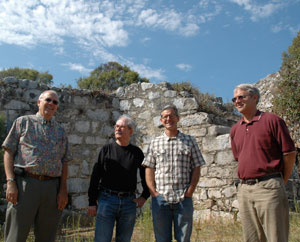Even now, inside one of the deteriorating cabins near the base of campus, you can see the rusty old bed frame where a lime worker slept 100 years ago.
UC Santa Cruz's newest Friends group, Friends of the Cowell Lime Works Historic District, aims to protect historical evidence such as this, as well as significant structures on campus dating from the 19th century.
"I think it's very important that we preserve that for future generations," said Frank Perry (College 8, '77), chairman of the board of the new Friends group and co-author of Lime Kiln Legacies, which traces the history of lime making in Santa Cruz County from 1791 to 1946.
"It's a really an interesting story," said Perry. "The area at the entrance to campus was the epicenter for lime making in California after the Gold Rush. It was the largest lime-making plant in the state at one time, so preserving the history has statewide significance--it's not just a local Santa Cruz thing."
Long understood locally to be an important historical resource, the former lime operations area--30 acres just inside the main entrance to campus--last year was added to the National Register of Historic Places, the nation's official list of significant cultural resources worthy of preservation.
Dubbed the Cowell Lime Works Historic District, the area includes the Granary, now a childcare center; the Cookhouse, now the Admissions office; several barns; the cooperage, where barrels for lime shipping were made; the ruins of former workers' cabins; the blacksmith shop; the Carriage House, now an office for University Relations, Arts & Lectures, Special Events, and the Alumni Association; Cardiff House, now the Women's Center but formerly the residence of lime works owner Henry Cowell; and the lime kilns themselves.
"The campus would benefit from restoring the resources of the district as an attraction for prospective students, staff, and faculty," said David Subocz (Kresge '89), who sits on the board of the Friends group and is also chairman of the Santa Cruz Historic Preservation Commission. "But a more important benefit would be demonstrating to the community and UC system that it values historic preservation and is a responsible steward in a time of serious budget constraints."
The mission of Friends of Cowell Lime Works Historic District is to aid in documentation, restoration, preservation, and interpretation of the historic lime kilns and related structures and buildings of the Cowell Lime Works Historic District and other historic sites on campus. The group received formal recognition as a Friends organization in June.
As for projects, "we've got lots," said Perry. "We're having trouble trying to narrow it down and focus on just a few. The hay barn, cabins, and cooperage are all about to collapse. So we feel like we're scrambling to put out fires. But at the same time, we want to get going on some other things like tours to create more public interest to generate money."
With the formal recognition as a Friends group, people can make monetary donations. They can also make donations of materials or time, said Perry.
Volunteers already started dismantling a small storage shed that probably dates from the 1860s and will be putting that back together soon, he said.
"That's the kind of thing volunteers can help with," said Perry. "We hope eventually to have volunteers helping to clean up around the historic buildings and doing minor maintenance things, doing additional historic research, and, maybe in the future, helping lead tours."
The group has received $2,200 in donations, including big gifts from the Cabrillo Civic Club, which is dedicated to the civic progress of Californians of Portuguese descent.
"A lot of the guys who lived in the cabins were Portuguese," said Perry. "So the club has an interest in seeing the buildings restored."
However, Perry estimated the Friends would need several hundred thousand dollars to restore the buildings as the members would like.
But for the group, working on the project is a labor of love.
"It's one thing to read about history. That's important," said Perry. "But it's something else to be able to go out and see and touch and smell history. I want people to be able to do that 50 or 100 years from now."



